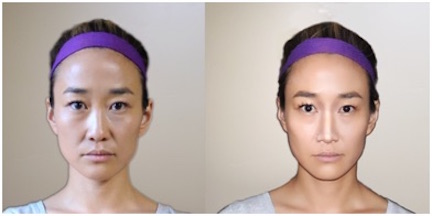The Utilization of the Nasal Aesthetic Subunits in Makeup Artistry
Jonathan A. Schwitzer, MD, Youna Choi, BS, James M. Economides, MD, Stephen B. Baker, MD, DDS, FACS.
MedStar Georgetown University Hospital, Washington, DC, USA.
BACKGROUND: The recent decline in rhinoplasty rates may be partially due to the increasing popularity of contour and highlighting makeup (CHM), which incorporates powder/cream formulations a few shades darker/lighter than natural skin tone. Contouring simulates shadows on the face, resulting in a receding effect of structures, while highlighting simulates reflective points of light to create a projecting effect. CHM can be combined for an amplified illusion of ridges and valleys. For example, to create the appearance of a slimmer dorsum, the desired width is outlined with a contouring shade with vertical lines to simulate the lateral ridges of the dorsum. Attached figure depicts before (left) and after (right) the application of CHM. CHM emphasis was on enhancement of the curvilinear dorsal aesthetic lines, dorsal projection, and infratip lobule retraction. Shimmer highlight was used on the radix, dorsum, and tip to maximize CHM effects. The purpose of this study was to examine the frequency and serendipitous interplay of CHM and the nasal aesthetic subunits, and investigate for cross-ethnic differences.
METHODS: A retrospective analysis of 100 unique publicly available Instagram social media posts was performed. Inclusion criteria included the term “#nosecontour”, visible CHM application, and clear display of the nose before and after CHM. Posts that appeared to utilize facial distortive applications or portrayed drastic anatomical changes suggesting prosthetic use/surgery were excluded.
RESULTS: 91% featured females. The most frequently utilized CHM techniques included lateral dorsum ridge contour (frequency 95%), dorsum highlight (85%), and tip highlight (77%). Significant cross-ethnic conformity included contour of lateral ridges of the dorsum (>90% of all ethnicities, SD 6.41) with the exception of Northeast Asian (81.81%) and White Brazilian (0%), and dorsum highlight (>90%, SD 11.93) with the exception of Hispanic (88.23%), Middle Eastern (83.83%) and Northeast Asian (72.72%). Notable ethno-specific rates included the highest frequency of columella and lateral alar borders contour in the Southeast Asian population (33.33% and 22.22%, respectively), and the highest frequency of sidewall contour in Middle Eastern subjects (33.33%). Cross-ethnic variance within each of the included CHM techniques was statistically significant per Kruskal-Wallis test (p < 0.0001), suggesting ethno-specific CHM and nasal subunit preferences.
CONCLUSIONS: These results depict a striking utilization of the nasal aesthetic subunits in makeup artistry, significant cross-ethnic agreement, as well as differences. Knowledge of CHM allows for insight into desired outcomes, and demonstrates the exciting collaborative potential of makeup artistry and plastic surgery for enhancement of surgical results. 
Back to 2019 Posters
